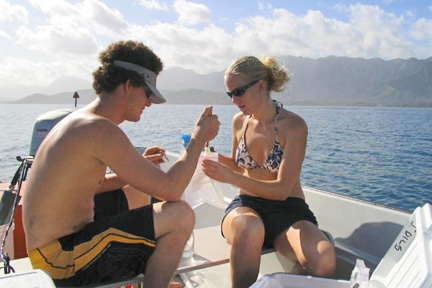
|
Reefs linked to
greenhouse gas
Coastal zones add heat-trapping
carbon dioxide to the air,
UH scientists find
Hawaii's coral reefs contribute to global warming by producing carbon dioxide when they calcify while building skeletons, University of Hawaii researchers have found.
UH scientists have been studying "coupled environments" of land and water in some of Hawaii's coastal zones to determine whether they emit carbon dioxide or absorb it as does the ocean.
Studies have shown about 8 billion tons of carbon are spewed into the atmosphere globally by fossil fuel burning and deforestation, and roughly 2 billion tons of carbon are taken up by the open ocean each year, UH oceanographer Fred Mackenzie said.
However, what happens in coastal zones has always been a big question, he said.
He and his colleagues, including research oceanographer Eric De Carlo and assistant oceanography professor Margaret McManus, have been running programs with graduate and undergraduate students looking at the exchange of carbon dioxide between the ocean and atmosphere.
They have studied Hilo Bay and the Enchanted Lake environment, and they are making nearly continuous measurements of discharges and suspended matter with instruments on a platform in Kaneohe Bay.
They recently extended their investigations to Kailua Bay, with oceanographer Chris Winn and technicians taking measurements by boat with Hawaii Pacific University and UH global environmental science students.
De Carlo said studies have been done on very large watersheds, but there is "a lack of characterization and understanding of what's going on in a lot of smaller watersheds" which "could have strong local impact and overall global impact."
The scientists had predicted from modeling that the coastal zone globally has been adding carbon dioxide to the atmosphere during the last several hundred years, Mackenzie said.
Their studies of Kaneohe Bay, Enchanted Lake and Hilo Bay show "all three on an annual basis are a net source of carbon dioxide to the atmosphere, not a sink like the open ocean," he said.
But global warming will bring some changes, he said, pointing out that as the ocean heats it cannot absorb as much carbon dioxide. "Like a bottle of Coke, as it heats up, carbon dioxide bubbles and the Coke is flat."
Until recently, little attention has been given to the effects on coral reefs, he said. But warming might increase bleaching of coral and eventually cause ocean water surrounding the reefs to take up CO2, which many do not seem to be doing now, he said.
That would add acid to the water, lowering its saturation and changing the coral's calcification rate, Mackenzie said.
"Along with all the other stresses on coral reefs of the world, this particular stress, warming and lowering pH (raising acidity) of the ocean, could be the last stress before these reefs really start to degrade."
De Carlo said their research might be expanded this summer to Oahu's South Shore, where Geno Pawlak, UH assistant professor of ocean engineering, is developing an observatory powered from shore with real-time transmission capabilities.
"We know that there was a huge dump under there (Kakaako Park)," De Carlo said. "Ground water seeps out. Are there any inputs that affect water quality in that area, and are these things that we can see? How do these physical processes, waves, currents and tides, affect those?"
It would be a very different but complementary study to Kaneohe Bay, he said, adding that similar work is being done in Hilo Bay.
De Carlo said there is a lot of collaboration with different agencies and leveraging of funds for the programs. A big advantage is they allow more training of undergraduates in research methods, he said. "We can train kids who are likely to remain here. Many graduates go on to work elsewhere."
[News] [Business] [Features] [Sports] [Editorial] [Do It Electric!]
[Classified Ads] [Search] [Subscribe] [Info] [Letter to Editor]
[Feedback]
